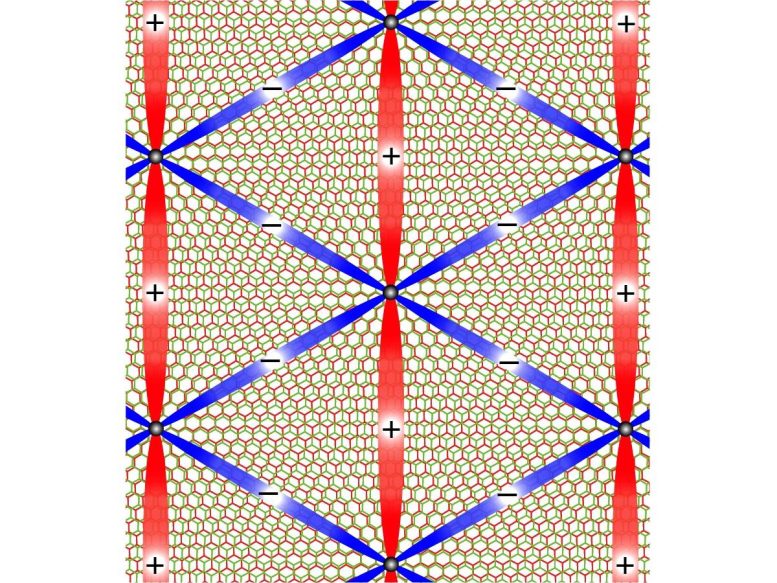
Researchers at Nagoya University are studying magic-angle twisted bilayer graphene (MATBG), a potential superconductor with unique properties, offering hope for practical, high-temperature superconductors.
Superconductors are materials that conduct electrical current with almost no electrical resistance at all. This property makes them particularly appealing for a variety of applications, including loss-less power cables, electric motors and generators, and powerful electromagnets that can be utilized for MRI imaging and magnetic levitating trains. Nagoya University researchers have now detailed the superconducting properties of a new class of superconducting material, magic-angle twisted bilayer graphene.
Low temperatures are required for a material to behave as a superconductor. In fact, most materials only enter the superconducting phase at extremely low temperatures, such as -270°C (-454°F), which is lower than the temperature observed in space! Because such substantial cooling necessitates highly expensive and specialized liquid helium cooling equipment, its practical uses are severely limited. This is the primary reason why superconducting technologies are still in their early stages.
High-temperature superconductors (HTS), such as some iron and copper-based ones, reach the superconducting phase above -200°C, a temperature that is more easily attained by cooling a device with liquid nitrogen, which can cool a system down to -195.8°C (-320.4°F). However, HTS’s industrial and commercial applications have been limited thus far. HTS materials that are currently known and available are brittle ceramic materials that are not bendable into usable shapes such as wires. Furthermore, they are notoriously difficult and expensive to produce. This makes the quest for novel superconducting materials vital, and it is a major focus of research for physicists like Prof. Hiroshi Kontani and Dr. Seiichiro Onari of Nagoya University’s Department of Physics.
Recently, a new material has been proposed as a potential superconductor called magic-angle twisted bilayer graphene (MATBG). In MATBG, two layers of graphene, essentially single two-dimensional layers of carbon arranged in a honeycomb lattice, are offset by a magic angle (about 1.1 degrees) that leads to the breakage of rotational symmetry and the formation of a high-order symmetry known as SU(4). As temperature changes, the system experiences quantum fluctuations, like water ripples in the atomic structure, that lead to a novel spontaneous change in the electronic structure and a reduction in symmetry. This rotational symmetry breaking is known as the nematic state and has been closely associated with superconducting properties in other materials.
Nematic State and Superconducting Properties
In their work published recently in Physical Review Letters, Prof. Kontani and Dr. Onari use theoretical methods to better understand and shine light on the source of this nematic state in MATBG. “Since we know that high-temperature superconductivity can be induced by nematic fluctuations in strongly correlated electron systems such as iron-based superconductors, clarifying the mechanism and origin of this nematic order can lead to the design and emergence of higher temperature superconductors,” explains Dr. Onari.
The researchers found that nematic order in MATBG originates from the interference between the fluctuations of a novel degree of freedom that combines the valley degrees of freedom and the spin degrees of freedom, something that has not been reported from conventional strongly correlated electron systems. The superconducting transition temperature of twisted bilayer graphene is very low, at 1K (-272°C), but the nematic state manages to increase it by several degrees.
Their results also show that although MATBG behaves in some ways like an iron-based high-temperature superconductor, it also has some distinct properties that are quite exciting, such as a net charge loop current giving rise to a magnetic field in a valley polarized state, while the loop current is canceled out by each valley in the nematic state. Besides, the malleability of graphene can also play an important role in increasing the practical applications of these superconductors.
With a better understanding of the underlying mechanisms of superconductivity, science and technology inch closer to a conducting future that is indeed super.
Reference: “SU(4) Valley+Spin Fluctuation Interference Mechanism for Nematic Order in Magic-Angle Twisted Bilayer Graphene: The Impact of Vertex Corrections” by Seiichiro Onari and Hiroshi Kontani, 9 February 2022, Physical Review Letters.
DOI: 10.1103/PhysRevLett.128.066401
Never miss a breakthrough: Join the SciTechDaily newsletter.
1 Comment
HO22 aiingOH22ing